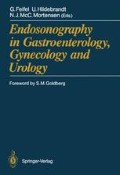Abstract
“Ultrasound” is the name given to a class of mechanical pressure waves that can be propagated to liquids, solids, and, to some extent, gases [1], Mechanical waves have frequencies which range from little more than 0 Hz up to several hundred million. For convenience, this vast range may be represented in the form of an acoustic spectrum, which is analogous to the more familiar spectrum of electromagnetic radiation. A typical frequency spectrum of mechanical waves is represented in Fig. 2.1, where a logarithmic scale has been chosen so that each tenfold increase in frequency is represented by an equal distance. The spectrum can be seen to consist of three broad regions, which overlap at their boundaries. The central region encompasses the audible spectrum from about 20–30 Hz up to about 16 Hz, these frequencies being the approximate lower and upper frequency limits of the average human ear. The region below about 20 Hz is designated infrasound, while frequencies greater than about 16 kHz are called ultrasound (US).
Access this chapter
Tax calculation will be finalised at checkout
Purchases are for personal use only
Preview
Unable to display preview. Download preview PDF.
References
Hueter TF, Bolt RH (1955) Sonics. Wiley, New York
Grossman CC et al. (eds) (1966) Diagnostic ultrasound. Plenum, New York
Wells PNT (1969) Physical principles of ultrasonic diagnosis. Academic, New York
Donald W, Baker BS (1974) Physical and technical principles. In: King D (ed) Diagnostic ultrasound. Mosby, St Louis
Gebhardt W, Schwarz H-P (1982) Untersuchungen zur Blasenwanddickenmessung und Gewebedifferenzierung mit einem transurethralen Scanner, Untersuchungsprotokoll für das Urologische Städtische Klinikum, Karlsruhe, May
Krautkrämer J (1975) Werkstoffprüfung mit Ultraschall. Springer, Berlin Heidelberg New York, p 20
Wells PNT (1977) Biomedical Ultrasound. Academic, London
Roy Williams A (1983) Ultrasound: biological effects and potential hazards. Academic, Medical Physics Series, London
Goebbels K (1984) Vortrag: Arbeitskreistagung Intercavitäre Sonographie, Universitätsklinik Homburg/Saar, Oct 6
Schueller J et al. (1981) Beurteilung von Blasenveränderung mit der intravesikalen Ultraschalltomographie. Urologe [A] 20: 204–210
Frentzel-Beyme B et al. (1982) Die transrektale Prostatasonographie. Computertomogr Sonogr Juni 2 (2): 58–112
Heyder N (1987) Endoscopic ultrasonography of tumors of the oesophagus and the stomach. Surg Endosc 1: 17–23
Souquet J (1982) Phased array transducer technology for transesophageal imaging of the heart. In: Hanrath P et al. (ed) Cardiovascular diagnosis by ultrasound. Nijhoff, The Hague, p 256
Prospect US: GF-UM2/EU-M2. Olympus Optical Co. (Europe)
Ferner H, Staubesand J (eds) (1982) Sobotta Atlas der Anatomie des Menschen, vol 2. Urban and Schwarzenberg, Munich
McElroy JT (1966) Focused ultrasonic beams. Automation Industry, Inc., Material Evaluation Group, Research Division, Boulder
Frey WJ, Dunn F (1962) Ultrasound: analysis and experimental methods in biological research. In: Nastuk WL (ed) Physical techniques in biological research, vol 4. Academic, New York, pp 261–394
Recorded by Dr. Hildebrandt, Department of Surgery, University of Saarland, FRG
Editor information
Editors and Affiliations
Rights and permissions
Copyright information
© 1990 Springer-Verlag Berlin Heidelberg
About this chapter
Cite this chapter
Schwarz, HP. (1990). Endosonography: Physical Basics and Instrumentation. In: Feifel, G., Hildebrandt, U., Mortensen, N.J.M. (eds) Endosonography in Gastroenterology, Gynecology and Urology. Springer, Berlin, Heidelberg. https://doi.org/10.1007/978-3-642-74252-1_2
Download citation
DOI: https://doi.org/10.1007/978-3-642-74252-1_2
Publisher Name: Springer, Berlin, Heidelberg
Print ISBN: 978-3-642-74254-5
Online ISBN: 978-3-642-74252-1
eBook Packages: Springer Book Archive

